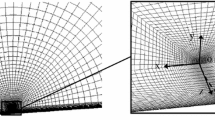Abstract
Focusing on the geometry of one hot spot in airframes, this paper discusses the onset of the interaction of two collinear cracks at adjacent holes and defines the onset as a criterion for multi-site fatigue damage failure. The finite element method is used to calculate the stress intensity factors at the tips of two collinear cracks at adjacent holes growing towards each other. The stress intensity factor is found to increase rapidly at the onset of interaction. Since a rapid increase in stress intensity factor results in a rapid and unstable growth of the crack, the onset of the interaction is proposed as the point where the multi-site fatigue damage starts. A criterion to avoid multi-site fatigue damage locally is then established based on the separation distance of two crack tips at the onset of the interaction. To speed up the simulation of crack growth under multi-site fatigue damage with the finite element method, a semi-empirical criterion is derived to determine the time at which the stress intensity factors at the tips of the cracks correlate. The numerical examples show that the proposed criterion saves simulation time while incurring negligible relative error in the computation of the final crack length.
Similar content being viewed by others
References
Anderson TL (2005) Fracture mechanics: fundamentals and applications, 3rd edn. CRC Press, Boca Raton
Asada H (1989) Reliability assessment of pressurized fuselages with multiple-site fatigue cracks. 5th international conference on structural safety and reliability, pp 2369–2372
Cherry MC, Mall S, Heinimann B, Grandt AF Jr (1997) Residual strength of unstiffened aluminum panels with multiple site damage. Eng Fract Mech 57(6): 701–713. doi:10.1016/S0013-7944(97)00037-4
Dowling NE (1998) Mechanical behavior of materials. Prentice Hall, New Jersey
Hijazi AL (2001) Residual strength of thin-sheet aluminum panels with multiple site damage. Ph.D. dissertation, Wichita State University
Hsu C, Lo J, Yu J, Lee X, Tan P (2003) Residual strength analysis using CTOA criteria for fuselage structures containing multiple site damage. Eng Fract Mech 70: 525–545. doi:10.1016/S0013-7944(02)00135-2
Hurtado J (2006) Airframe integrity based on Bayesian approach. Ph.D. dissertation, University of Maryland
Jones R, Williams JF, Heller M (1993) Interaction of multi-site cracks. 5th Australian aeronautical conference, Melbourne, Australia, pp 471–477
Jones R, Molent L, Pitt S (1999) Study of multi-site damage of fuselage lap joints. Theor Appl Fract Mech 32: 81–100. doi:10.1016/S0167-8442(99)00029-4
Kuang JH, Chen CK (1998) The failure of ligaments due to multiple-site damage using interactions of Dugdale-type cracks. Fatigue Fract Eng Mater Struct 21: 1147–1156. doi:10.1046/j.1460-2695.1998.00070.x
Leek TH, Howard IC (1996) An examination of methods of assessing interacting surface cracks by comparison with experimental data. Int J Press Vessels Pip 68: 181–201. doi:10.1016/0308-0161(94)00052-2
Li W, Siegmund T (2002) An analysis of crack growth in thin-sheet metal via a cohesive zone model. Eng Fract Mech 69: 2073–2093. doi:10.1016/S0013-7944(02)00013-9
Mar JW (1991) Structural integrity of aging airplanes; A perspective. In: Alturi SN, Sampath SG, Tong P Structural integrity of aging airplanes. Springer-Verlag, Berlin
Moukawsher EJ, Grandt AF Jr, Neussl MA (1996) Fatigue life of panels with multiple site damage. J Aircr 33(5): 1003–1013. doi:10.2514/3.47047
Mousa WA (1998) Risk-based reliability evaluation of multi-site damage in pipelines. Comput Ind Eng 35: 595–598. doi:10.1016/S0360-8352(98)00167-3
Newman JC, James MA, Zerbst U (2003) A review of the CTOA/CTOD fracture criterion. Eng Fract Mech 70: 371–385. doi:10.1016/S0013-7944(02)00125-X
Orisamolu IR (1996) Probabilistic assessment of multiple site damage in aircraft structures. A collection of technical papers—AIAA/ASME/ASCE/AHS/ASC structures, structural dynamics & materials conference, 1, 377–384
Paris PC, Gomez M, Anderson W (1961) A rational analytic theory of fatigue. Trend Eng 13: 9
Park JH, Atluri SN (1998) Mixed mode fatigue growth of curved cracks emanating from fastener holes in aircraft lap joints. Comput Mech 21: 477–482. doi:10.1007/s004660050326
Proppe C (2003) Probabilistic analysis of multi-site damage in aircraft fuselages. Comput Mech 30: 323–329. doi:10.1007/s00466-002-0408-x
Rooke DP (1986) Compounding stress intensity factors, applications to engineering structures, Research Reports in Material Science, Series One, Parthenon Press
Schijve J (1995) Multiple-site damage in aircraft fuselage structures. Fatigue Fracture Eng Mater Struct 18: 329–344. doi:10.1111/j.1460-2695.1995.tb00879.x
Smith BL, Saville PA, Mouak A, Myose RY (2000) Strength of 2024-T3 aluminum panels with multiple site damage. J Aircr 37: 325–331. doi:10.2514/2.2597
Swift T (1992) Damage tolerance capability. In: Proceedings of the specialists conferences on fatigue of aircraft materials, Delft, The Netherlands, pp 351–387
Tada H, Paris PC, Irwin GR (1985) The stress analysis of cracks handbook, 2nd edn. Del Research Corp., Hellertown, PA
Wang YZ, Atkinson JD, Akid R, Parkins RN (1996) Crack interaction, coalescence and mixed mode fracture mechanics. Fatigue Fract Eng Mater Struct 19(4): 427–439. doi:10.1111/j.1460-2695.1996.tb00979.x
Xiong Y, Shi G (2001) Stochastic damage growth model for fuselage splices with multisite damage. AIAA J 39(3): 498–503. doi:10.2514/2.1333
Zerbst U, Heinimann M, Donne CD, Steglich D (2009) Fracture and damage mechanics modeling of thin-walled structures—an overview. Eng Fract Mech 76: 5–43. doi:10.1016/j.engfracmech.2007.10.005
Author information
Authors and Affiliations
Corresponding author
Rights and permissions
About this article
Cite this article
Wang, X., Modarres, M. & Hoffman, P. Analysis of crack interactions at adjacent holes and onset of multi-site fatigue damage in aging airframes. Int J Fract 156, 155–163 (2009). https://doi.org/10.1007/s10704-009-9354-3
Received:
Accepted:
Published:
Issue Date:
DOI: https://doi.org/10.1007/s10704-009-9354-3




